 After Venice, our next trip out was to the city of Verona which is famous for its operas and the location of Shakespeare's Romeo and Juliet (more later). Verona became an important city after the Romans conquered the Italian peninsula due to its strategic location at the intersection of several roads. Coaches are not allowed to drive into the city so we were dropped off on the other side of the River Adige and although a shuttle is available we walked across the bridge into the city. The first sight you see is the impressive city wall which is over 40 feet high. The city’s entire central area is listed as an UNESCO world heritage site. The area around the arena is a bit spoilt, I think, by the necessity of storing the props for various operas outside the arena so that they can more easily be moved inside when required. These props are from Aida I think.
After Venice, our next trip out was to the city of Verona which is famous for its operas and the location of Shakespeare's Romeo and Juliet (more later). Verona became an important city after the Romans conquered the Italian peninsula due to its strategic location at the intersection of several roads. Coaches are not allowed to drive into the city so we were dropped off on the other side of the River Adige and although a shuttle is available we walked across the bridge into the city. The first sight you see is the impressive city wall which is over 40 feet high. The city’s entire central area is listed as an UNESCO world heritage site. The area around the arena is a bit spoilt, I think, by the necessity of storing the props for various operas outside the arena so that they can more easily be moved inside when required. These props are from Aida I think.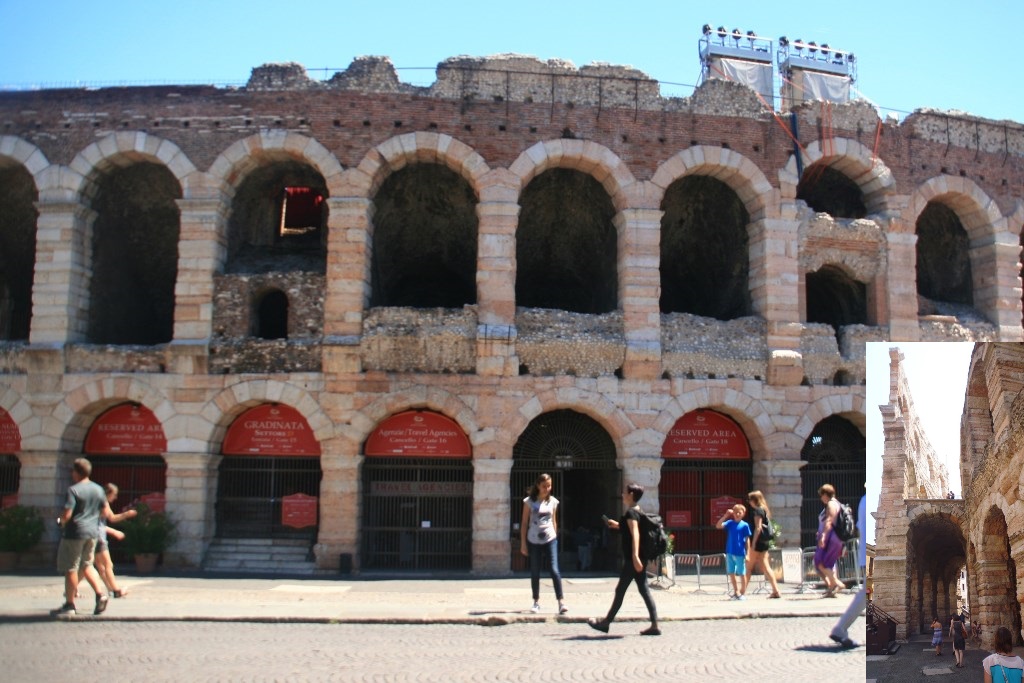 The Verona Arena is a Roman amphitheatre, smaller only than the Colosseum and the Amphitheatre of Capua, built in its original form in AD30 for the ludi (shows and games) as well as gladiator fights. An earthquake in 1117 all but destroyed the outer ring with only 4 arches now remaining (inset). Over subsequent years much of the original stonework was taken and used for construction of other buildings; at the time, the historical importance of the arena was not fully appreciated so I guess this was a form of re-cycling! The arena was first used as a theatre during the Renaissance and during the 1850's some operatic performances were held in the arena until in 1913, operatic performances commenced in earnest. Until quite recently (2011) there had been no additional microphones or accoustic aids due to the outstanding natural accoustics of the arena itself. As well as regular operas, the arena has also hosted several concerts of international rock and pop bands.
The Verona Arena is a Roman amphitheatre, smaller only than the Colosseum and the Amphitheatre of Capua, built in its original form in AD30 for the ludi (shows and games) as well as gladiator fights. An earthquake in 1117 all but destroyed the outer ring with only 4 arches now remaining (inset). Over subsequent years much of the original stonework was taken and used for construction of other buildings; at the time, the historical importance of the arena was not fully appreciated so I guess this was a form of re-cycling! The arena was first used as a theatre during the Renaissance and during the 1850's some operatic performances were held in the arena until in 1913, operatic performances commenced in earnest. Until quite recently (2011) there had been no additional microphones or accoustic aids due to the outstanding natural accoustics of the arena itself. As well as regular operas, the arena has also hosted several concerts of international rock and pop bands.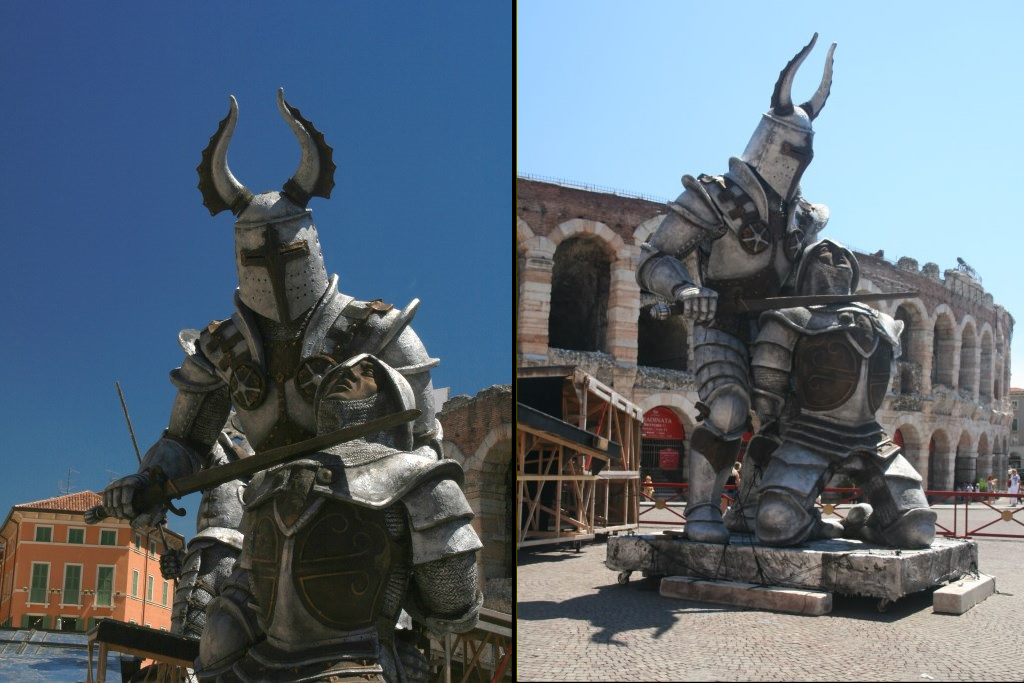 These are the very impressive props from the opera Il Trovotore, which together with Rigoletto and La Traviata, is part of the so-called “Popular Trilogy”, by Giuseppe Verdi about love and revenge - in Italy, what else would it be about.
These are the very impressive props from the opera Il Trovotore, which together with Rigoletto and La Traviata, is part of the so-called “Popular Trilogy”, by Giuseppe Verdi about love and revenge - in Italy, what else would it be about.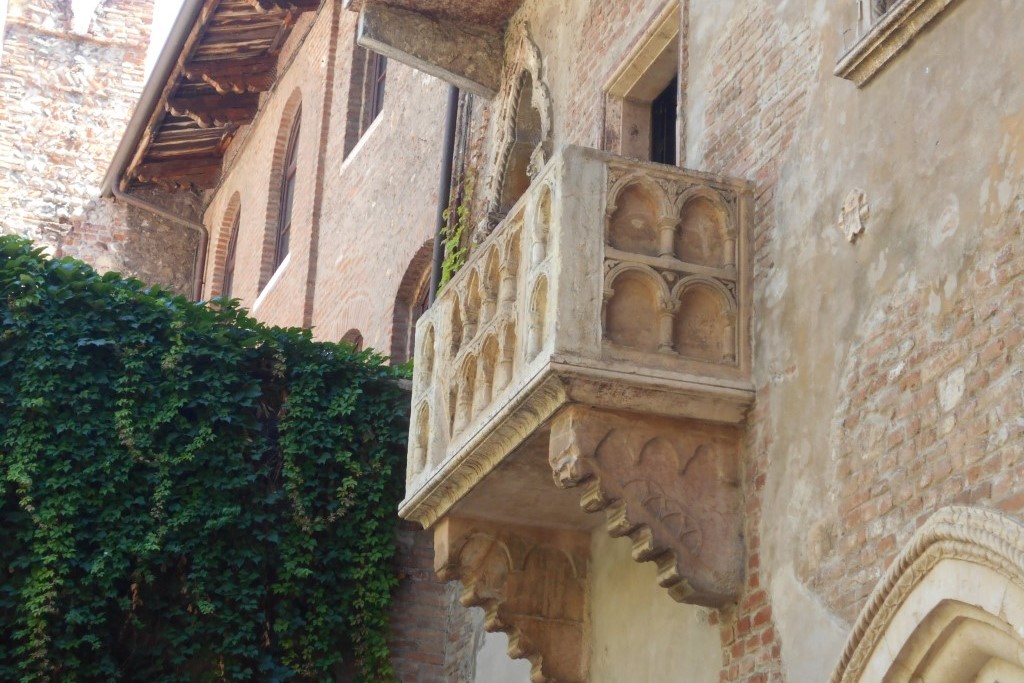 Verona is arguably most famous as the location of the play by Shakespeare of Romeo and Juliet. In brief,
Verona is arguably most famous as the location of the play by Shakespeare of Romeo and Juliet. In brief,
'Romeo and Juliet fall in love at a party although their families (the Montagues - Romeo and Capulets - Juliet) hate each other and would not give permission for them to marry. Helped by Friar Laurence, they marry in secret but unfortunately, before their wedding night Romeo kills Juliet's cousin in a duel; in the morning he is forced to leave to avoid being put to death. Juliet's parents don't know she is married and tell her she must marry Paris; she initially refuses but later agrees because she plans to fake her death and escape to be with Romeo forever. Friar Laurence gives Juliet a sleeping potion and as she appears to be dead she is put in a tomb. However, Romeo does not know about the plan, visits her grave, thinks she is dead, and kills himself. When Juliet finally wakes up, she discovers that Romeo is dead and then kills herself.'
Shakespeare is believed to have wriiten his play between 1591 and 1595 and he based it on an earlier Italian tale by Aurthur Brooke in 1562 - so a bit of plagiarism there then! Two other plays by Shakespeare (Taming of the Shrew and Two Gentlemen of Verona) were also based in Verona.
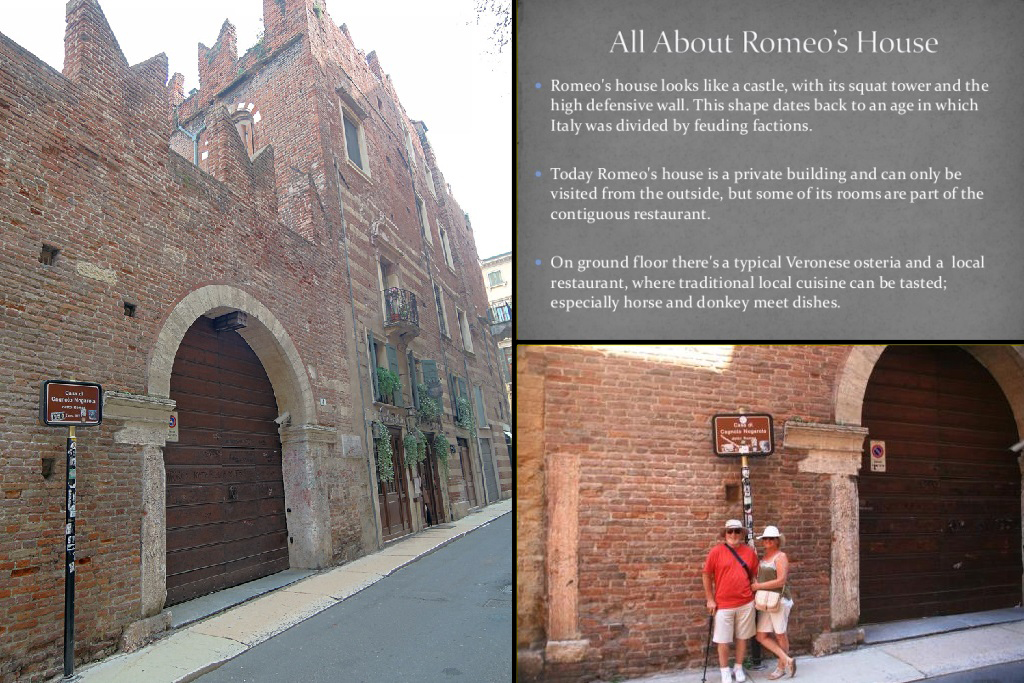 After visiting the site of the famous 'balcony', which incidentally was built in 1922 especially for the pre-war tourists (LOL), we decided to visit Romeos house which is not far from Juliets (we were told). This caused some hilarity as we were unable to find it and had to ask a passer-by who told us we were standing right outside it; accepted it is a private dwelling but we had expected something a bit more grand and obvious. The tragic story of Romeo and Juliet is a legend, nobody can tell if the two unlucky lovers of Verona ever lived; nevertheless, there is some historical truth in the story. The Montecchi family (Montague in English) really existed in Verona, and lived in a fortress which is now considered Romeo's house; there was also a bloody struggle between the Guelphs and Ghibellines which could have been the source of hate between the two families.
After visiting the site of the famous 'balcony', which incidentally was built in 1922 especially for the pre-war tourists (LOL), we decided to visit Romeos house which is not far from Juliets (we were told). This caused some hilarity as we were unable to find it and had to ask a passer-by who told us we were standing right outside it; accepted it is a private dwelling but we had expected something a bit more grand and obvious. The tragic story of Romeo and Juliet is a legend, nobody can tell if the two unlucky lovers of Verona ever lived; nevertheless, there is some historical truth in the story. The Montecchi family (Montague in English) really existed in Verona, and lived in a fortress which is now considered Romeo's house; there was also a bloody struggle between the Guelphs and Ghibellines which could have been the source of hate between the two families. We continued on our tour of Verona, carefully avoiding the shops, much to Olwen's disgust, and close to Romeo's house we found the Arche Scaligere, the tombs of the Scala Family. The Scala family ruled Verona and many other Italian cities from the end of the thirteenth century until the end of the fourteenth century; I have already mentioned about their occupation of parts of Lake Garda - Sirmioni and Lazise - including the many castles and fortifications they built. The feud between the Guelph and Ghibelline parties to which the Scala family belonged, is thought to be behind the Romeo and Juliet legend.
We continued on our tour of Verona, carefully avoiding the shops, much to Olwen's disgust, and close to Romeo's house we found the Arche Scaligere, the tombs of the Scala Family. The Scala family ruled Verona and many other Italian cities from the end of the thirteenth century until the end of the fourteenth century; I have already mentioned about their occupation of parts of Lake Garda - Sirmioni and Lazise - including the many castles and fortifications they built. The feud between the Guelph and Ghibelline parties to which the Scala family belonged, is thought to be behind the Romeo and Juliet legend.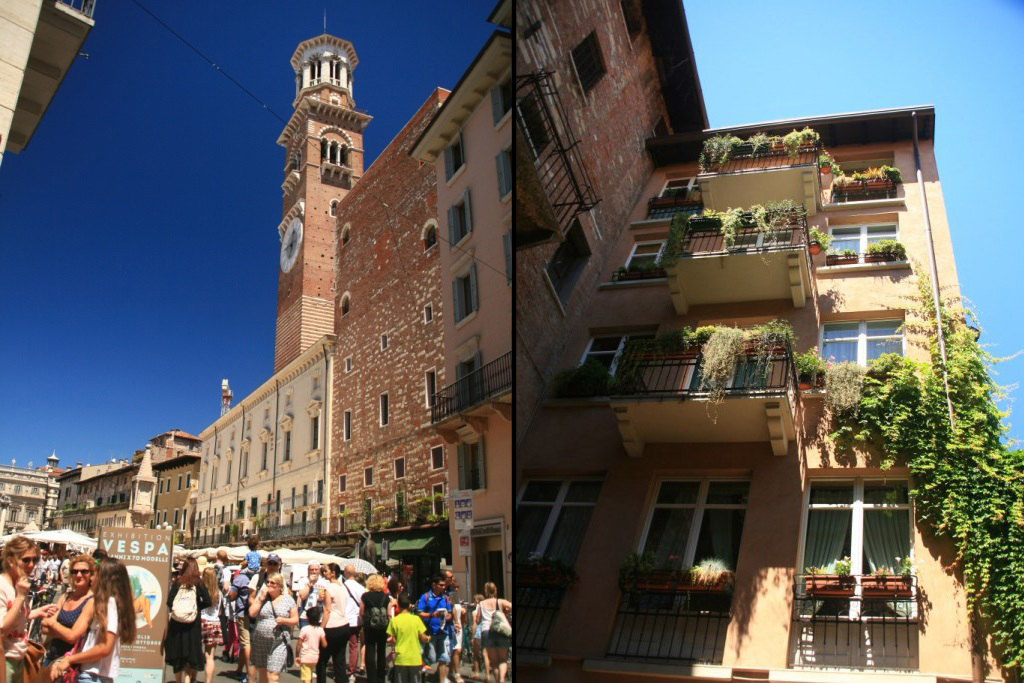 The Torre dei Lamberti, built by the powerful Lamberti Family in 1172 in the centre of Verona is, at 84 metres high, the tallest of Verona’s towers. Most of these bell towers were built as a sign of a family's wealth and this tower has two famous bells, the Rengo and the Marangona, which kept time and regulated city life. The Marangona signalled the end of the working day for the artisans (marangon) and also sounded the alarm in case of fire, whilst the Rengo summoned the town Council and citizens of Verona in times of war; the bells still ring during funerals. The private building on the right is typically Italian and has challenged me to decorate my own balcony with hanging baskets and flower arrangement next summer (LOL).
The Torre dei Lamberti, built by the powerful Lamberti Family in 1172 in the centre of Verona is, at 84 metres high, the tallest of Verona’s towers. Most of these bell towers were built as a sign of a family's wealth and this tower has two famous bells, the Rengo and the Marangona, which kept time and regulated city life. The Marangona signalled the end of the working day for the artisans (marangon) and also sounded the alarm in case of fire, whilst the Rengo summoned the town Council and citizens of Verona in times of war; the bells still ring during funerals. The private building on the right is typically Italian and has challenged me to decorate my own balcony with hanging baskets and flower arrangement next summer (LOL).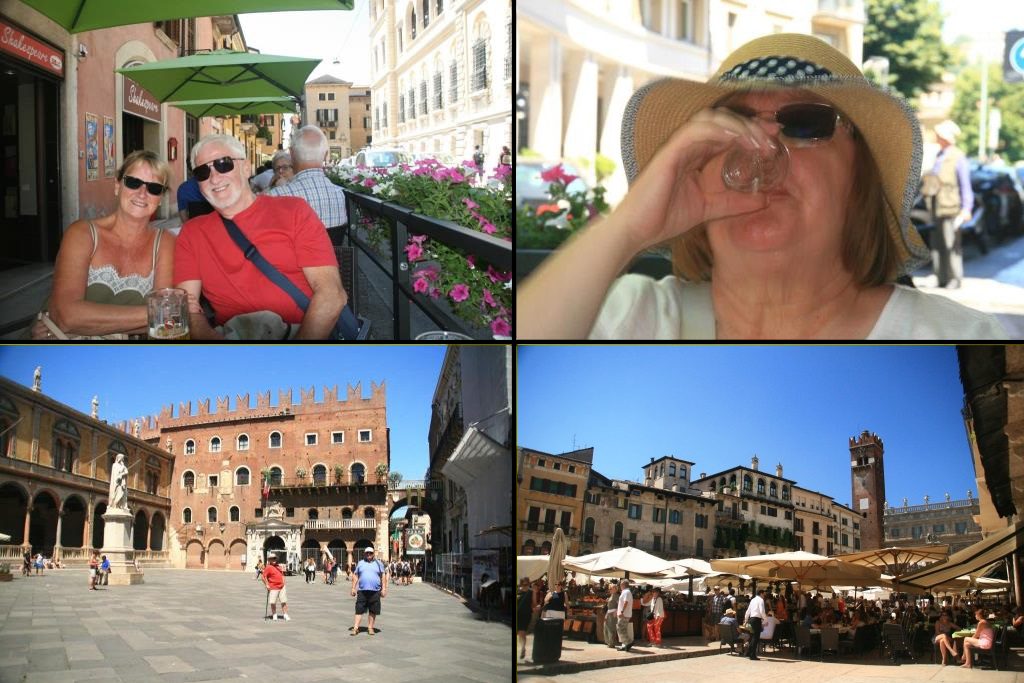 We continued to walk back through Verona heading back to the coach; the Piazza dei Signori has the statue of the poet Dante Alighieri in the middle and was the former centre of power in Verona. Around the beautiful square all the important main buildings of the former city government, including the court and the seat of power of the Scaliger family, are located. We arrived then at the Piazza delle Erbe which has many cafes as well as market stalls and was once the town's forum during the time of the Roman Empire. Olwen got her chance to have a little shop before we crossed back over the bridge to the coach park for the journey back to Lake Garda.
We continued to walk back through Verona heading back to the coach; the Piazza dei Signori has the statue of the poet Dante Alighieri in the middle and was the former centre of power in Verona. Around the beautiful square all the important main buildings of the former city government, including the court and the seat of power of the Scaliger family, are located. We arrived then at the Piazza delle Erbe which has many cafes as well as market stalls and was once the town's forum during the time of the Roman Empire. Olwen got her chance to have a little shop before we crossed back over the bridge to the coach park for the journey back to Lake Garda.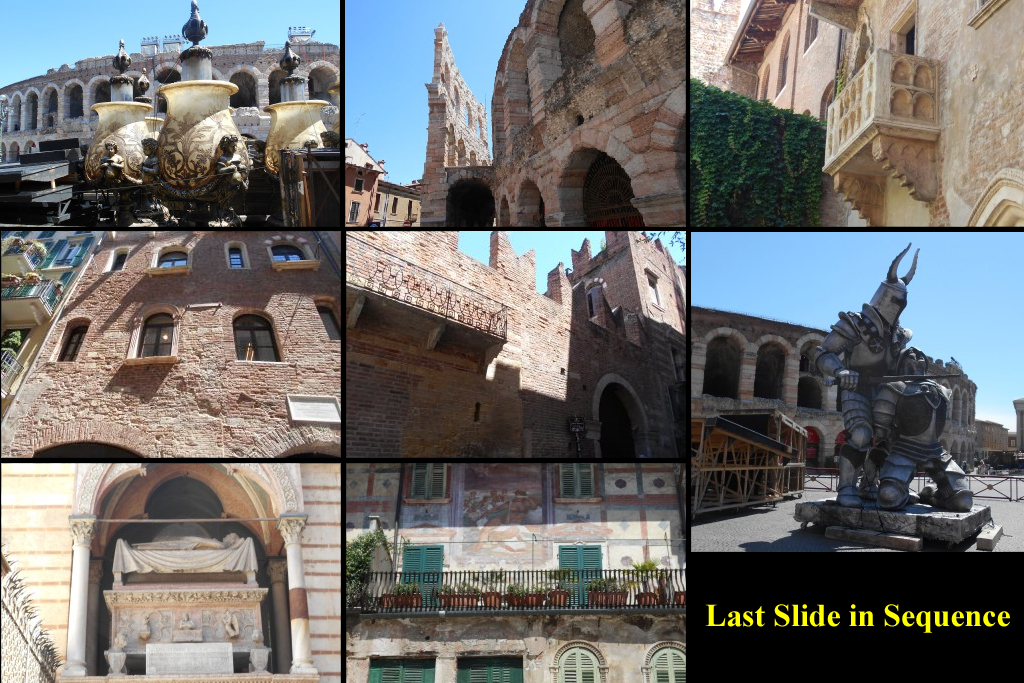 First visit to Verona, probably our last as I thought it was a bit cluttered around the Arena where the operas are performed; this is probably inevitable as they have to store the very large props somewhere and the square outside it is the only place. Also the 'balcony' and Romeo's house were a great disappointment, especially as the balcony was built for the tourists and it was almost impossible to get into the small courtyard because of the numbers of people. We didn't even know we had found Romeo's house, it was so inconspicuous. So all in all the tourism is down to a fictional story written by Shakespeare (supposedly) and a Roman amphitheatre used for opera performances which we didn't see (a shame). Oh well at least we can say we've been there!
First visit to Verona, probably our last as I thought it was a bit cluttered around the Arena where the operas are performed; this is probably inevitable as they have to store the very large props somewhere and the square outside it is the only place. Also the 'balcony' and Romeo's house were a great disappointment, especially as the balcony was built for the tourists and it was almost impossible to get into the small courtyard because of the numbers of people. We didn't even know we had found Romeo's house, it was so inconspicuous. So all in all the tourism is down to a fictional story written by Shakespeare (supposedly) and a Roman amphitheatre used for opera performances which we didn't see (a shame). Oh well at least we can say we've been there!